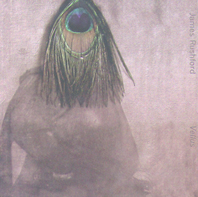: james rushford
Cajid, 2008, 009
http://cajid.com/
This is a cracker of a CD, one of the best sound art releases I have heard. Rushford is a young composer and performer who has assembled some fine musicians to record his work. What is especially striking is the production, which is clear and articulate, with an intimate sound-stage so that the music envelops you, recreating the immersive effect of the typical multi-speaker sound art concert venue, and demanding a robust, quality stereo system that can accurately reproduce the entire audible frequency range.
It opens with the energetic three movement work “Lucas Stumbles” (2007) for Speak Percussion (Eugene Ughetti, Matthias Schack-Arnott, Greg Sully, Anna Webb) and electronics. Speak uses a variety of instruments, as well as voice, in an absorbing piece characterised by a kind of gestural, even theatrical lyricism. This is followed by a two-part work, “Respite in the Woodland” (2007), for clarinets (Aviva Endean) and chamber organ (Rushford), a more meditative piece that contrasts the breathiness of the clarinets with that of the organ. Opening with some gentle, quizzical melodic lines, the work then proceeds to explore the capacities of the instruments to blend and create evocative sonic effects, returning periodically to melodic figures as a daydreamer returns to purposive thought.
The outstanding work on the CD is “La Madre” (2006), for an ensemble comprising two sopranos, cello, percussion and electronics. “La Madre” has a strongly theatrical flavour, full of teasing sounds that evoke a complex drama. This is followed by the highly expressive “Tractus” (2006), for autoharp, violin, viola, cello, double bass, tam-tam and glockenspiel, which exemplifies Rushford’s acute and powerful writing.
Central to all the works on this CD are contrasting pitch, timbre, colour, dynamics and sonic blending. But also important are the music’s formal development and resolution. Rushford’s are well crafted compositions, where ‘resolution’ can be found structurally and timbrally. What works particularly well is his juxtaposition of electronic and acoustic instruments. Sound art can sometimes disappoint through the coldness of electronic instrumentation, and combining acoustic instruments with electronics can be like combining oil paint with a screen saver—it can work conceptually but fail to stir the soul. Rushford, however, uses electronics in subtle ways that meld with the other instruments, sometimes augmenting or heightening an acoustic sound, for example in “holdmegentlytightly” (2006) for Sam Dunscombe’s vibrant clarinet and Rushford’s own electronics, and sometimes contrasting it, for example in “La Madre”, where a periodic drone of seismic intensity suggests that the world is vibrating beneath our feet. There are also moments where the acoustic instruments seem to represent actors and the electronics suggest the audience’s internal, subjective responses.
Importantly, the use of timbre is not merely exploratory but is integral to the composition. For example, Endean’s beautiful clarinet notes in “Respite in the Woodland” are used to create a wonderfully haunting effect, as if the listener is groping blindfolded in a labyrinthine forest, observed by goblins and spirits. Shifts in timbre can be used to resolve moments of tension—or to leave them unresolved. Overall, Rushford’s choice of instrumentation works very well. He allows the performers scope to display their abilities while foregrounding the unique sonic properties of the instruments that underpin the composition. This makes for enchanting music.
Vellus concludes with the deeply introspective “Borders” (2006), a two-movement solo for Chloe Smith’s magnificent double bass, where the composer and the performer hold the emotional tension wonderfully. This final piece exemplifies the strengths of this CD: the writing and arranging, supported by great performances.
Chris Reid






